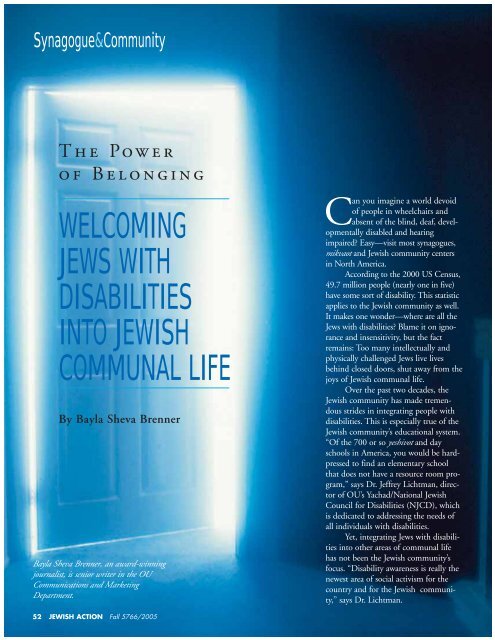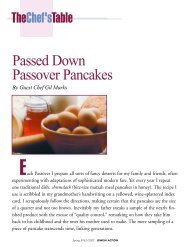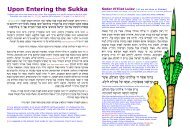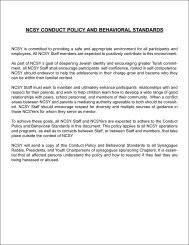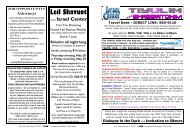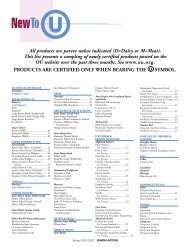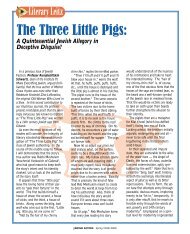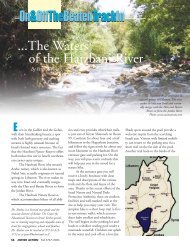welcoming jews with disabilities into jewish ... - Orthodox Union
welcoming jews with disabilities into jewish ... - Orthodox Union
welcoming jews with disabilities into jewish ... - Orthodox Union
Create successful ePaper yourself
Turn your PDF publications into a flip-book with our unique Google optimized e-Paper software.
Synagogue&Community<br />
The Power<br />
of Belonging<br />
WELCOMING<br />
JEWS WITH<br />
DISABILITIES<br />
INTO JEWISH<br />
COMMUNAL LIFE<br />
By Bayla Sheva Brenner<br />
Bayla Sheva Brenner, an award-winning<br />
journalist, is senior writer in the OU<br />
Communications and Marketing<br />
Department.<br />
Can you imagine a world devoid<br />
of people in wheelchairs and<br />
absent of the blind, deaf, developmentally<br />
disabled and hearing<br />
impaired? Easy—visit most synagogues,<br />
mikvaot and Jewish community centers<br />
in North America.<br />
According to the 2000 US Census,<br />
49.7 million people (nearly one in five)<br />
have some sort of disability. This statistic<br />
applies to the Jewish community as well.<br />
It makes one wonder—where are all the<br />
Jews <strong>with</strong> <strong>disabilities</strong>? Blame it on ignorance<br />
and insensitivity, but the fact<br />
remains: Too many intellectually and<br />
physically challenged Jews live lives<br />
behind closed doors, shut away from the<br />
joys of Jewish communal life.<br />
Over the past two decades, the<br />
Jewish community has made tremendous<br />
strides in integrating people <strong>with</strong><br />
<strong>disabilities</strong>. This is especially true of the<br />
Jewish community’s educational system.<br />
“Of the 700 or so yeshivot and day<br />
schools in America, you would be hardpressed<br />
to find an elementary school<br />
that does not have a resource room program,”<br />
says Dr. Jeffrey Lichtman, director<br />
of OU’s Yachad/National Jewish<br />
Council for Disabilities (NJCD), which<br />
is dedicated to addressing the needs of<br />
all individuals <strong>with</strong> <strong>disabilities</strong>.<br />
Yet, integrating Jews <strong>with</strong> <strong>disabilities</strong><br />
<strong>into</strong> other areas of communal life<br />
has not been the Jewish community’s<br />
focus. “Disability awareness is really the<br />
newest area of social activism for the<br />
country and for the Jewish community,”<br />
says Dr. Lichtman.<br />
52 JEWISH ACTION Fall 5766/2005
If Stairs Could Speak<br />
Ironically, the most visibly disabled<br />
population, those in wheelchairs,<br />
could very well be the most overlooked.<br />
They would tell you that if<br />
stairs could speak, they would say,<br />
“No!”<br />
Twenty-five years ago, long before<br />
accessibility entered the American consciousness,<br />
the Hebrew Institute of<br />
Riverdale, in New York, built a new<br />
synagogue <strong>with</strong> a ramp for every<br />
incline. A few years later, the shul<br />
added another ramp leading to the<br />
bimah.<br />
“A young man in the community<br />
became a paraplegic,” relates Rabbi Avi<br />
Weiss, rav of the shul. “At my son’s Bar<br />
Mitzvah, I asked him to come up for<br />
an aliyah. He could not come on his<br />
own to the bimah and refused to be<br />
lifted. He said, ‘When I come to the<br />
Torah, I will come on my own, <strong>with</strong><br />
dignity or not at all.’” Rabbi Weiss had<br />
the ramp to the bimah installed <strong>with</strong><br />
funds raised by his congregants.<br />
“People will always give to a project<br />
that makes sense,” he says.<br />
Dr. Shmuel M. Gedwiser of Brookline,<br />
Massachusetts, loves to dance at weddings. He<br />
maneuvers his wheelchair before the bride and<br />
groom and spins around as an expression of simchat<br />
chatan vekallah. On the back of his wheelchair<br />
hangs a sign that says it all, “Ketzad merakdin<br />
lifnei hakallah—Dance in front of the kallah any<br />
way you can.” Photo: Dr. Irving Ehrlich<br />
“Growing up, I can tell you<br />
there were no synagogues in my area<br />
that were accessible [to people <strong>with</strong><br />
<strong>disabilities</strong>],” says Chava Willig Levy, a<br />
writer, editor and lecturer who lives in<br />
Long Island, New York. “At my mother’s<br />
levayah [funeral] fourteen years<br />
ago, I remember being carried up in<br />
my wheelchair twenty or more steps.<br />
A year ago, my father<br />
passed away, and the<br />
levayah was held in the<br />
same shul. I expected<br />
the same situation.<br />
When I got to the<br />
front of the building, a<br />
friend informed me<br />
that the shul now had<br />
a ramp.” Levy, who<br />
contracted polio at age<br />
three, credits the community<br />
for the change.<br />
Before observant<br />
Jews consider putting<br />
down roots in any<br />
community, the two<br />
musts are mikvah and<br />
minyan. However,<br />
many individuals <strong>with</strong><br />
physical <strong>disabilities</strong><br />
have<br />
to do <strong>with</strong>out these essentials.<br />
Close to thirty years ago,<br />
shortly after a new mikvah<br />
opened in the West Rogers<br />
Park section of Chicago, a<br />
member of the kehillah<br />
became disabled. The community<br />
raised the funds to install<br />
a manually operated hydraulic<br />
lift (commonly used in rehabilitation<br />
facilities for the disabled).<br />
To ensure that the<br />
immersion is halachically<br />
valid, a chair made of (completely<br />
porous) nylon mesh is<br />
connected to the lift so as not<br />
to impede the flow of water.<br />
A bicycle accident in the<br />
mid-eighties that left a woman<br />
a paraplegic prompted the<br />
Teaneck, New Jersey, community<br />
to make its mikvah handicap<br />
accessible. “I thought it<br />
According to Suri Crawford, grant<br />
writer for the OU, shuls interested<br />
in accessibility but strapped for cash<br />
can obtain funds from various<br />
foundations. For more information,<br />
call 212-613-8170.<br />
The Hebrew Institute of Riverdale is completely wheelchair<br />
accessible. The ramp leading up to the bimah—the first of<br />
its kind—was built almost twenty years ago. Photo courtesy<br />
of The Hebrew Institute of Riverdale<br />
was untenable that a woman who<br />
wants to observe the laws of taharat<br />
hamishpachah [family purity] wouldn’t<br />
be able to do so,” says Rabbi Aryeh<br />
Weil, who, at the time, was the rav of<br />
Congregation B’nai Yeshurun in<br />
Teaneck. Rabbi Weil recalled an article<br />
he had read about a special lift used at<br />
a mikvah in Jerusalem. The congregants<br />
provided the necessary donations,<br />
and the renovations were completed in<br />
six months. “I don’t think we should be<br />
patted on the back,” says Rabbi Weil.<br />
“It was our obligation.”<br />
In 1990, Congress passed the<br />
long-overdue Americans <strong>with</strong><br />
Disabilities Act (ADA). This groundbreaking<br />
statute granted equal opportunity<br />
for individuals <strong>with</strong> <strong>disabilities</strong>,<br />
and mandated, among other things,<br />
that all government facilities and public<br />
transportation be accessible to the disabled.<br />
Unfortunately, houses of worship<br />
are exempt.<br />
Fall 5766/2005 JEWISH ACTION 53
Tips on Making<br />
Your Shul Accessible<br />
1. The Building:<br />
• Are there steps at the entrance or<br />
<strong>with</strong>in the building? Is there a<br />
ramp(s) to accommodate a wheelchair?<br />
• Are all doors wide enough to<br />
accommodate a wheelchair?<br />
2. Accessible Entrance:<br />
• If the main entrance is not accessible,<br />
is there an alternate entrance?<br />
• Are there curb cuts close to the<br />
entrance?<br />
3. Restrooms:<br />
• Is there a stall designated to<br />
accommodate a wheelchair?<br />
• Is the seat the proper height?<br />
4. The Bimah:<br />
• Is there a ramp to the bimah?<br />
5. Provisions for the Blind and<br />
Visually Impaired:<br />
• Are Braille and large-print<br />
Chumashim and siddurim set aside in<br />
a designated area?<br />
6. Provisions for the Deaf and<br />
Hearing Impaired:<br />
• Is there a sign language interpreter?<br />
7. Special Needs Children:<br />
• Do you have “shadows” to supervise<br />
children participating in<br />
Shabbat groups?<br />
Capacity of Seating Number of Required<br />
in an Assembly Area Wheelchair Locations<br />
4 to 25 1<br />
26 to 50 2<br />
51 to 300 4<br />
301 to 500 6<br />
Over 500<br />
6, plus 1 for each<br />
additional hundred seats<br />
“In a rare move of unity, all the<br />
major religions banded together in a<br />
motion to be exempt from the ADA<br />
mandate,” says Dr. Lichtman. “Like<br />
so much in life, it came down to dollars<br />
and cents. One would think<br />
shuls would be the first to take on<br />
such an obligation [and become<br />
accessible],” says Dr. Lichtman. “I<br />
believe [not doing so] is not due to<br />
prejudice, but to ignorance.”<br />
Dr. Lichtman admits that physical<br />
accessibility has not been<br />
Yachad’s main concern. “Our priority<br />
has been reaching the community<br />
and making inroads in changing attitudes<br />
towards accessibility in general,”<br />
he says. “Bringing the Yachad<br />
program to many communities has<br />
helped to knock down barriers and<br />
raise awareness. I believe that, as a<br />
result, it makes it easier to begin to<br />
talk about physical access.”<br />
Despite the legal exemption<br />
from being handicap accessible,<br />
many shuls undergoing construction<br />
or renovation have opted to include<br />
accessibility in their building plans.<br />
“Since the ADA has been in effect,<br />
architects have become more versed<br />
in incorporating ramps in their blueprints,”<br />
says Jason Lieberman, director<br />
of government and community<br />
affairs at Yachad. “Overall, it’s much<br />
more cost-effective to build the ramp<br />
when designing the building than<br />
constructing [one] later.” An informal<br />
OU survey found that more and<br />
more communities are answering the<br />
accessibility call. Close to seventy<br />
<strong>Orthodox</strong> synagogues throughout<br />
North America responded<br />
<strong>with</strong> a resounding “Yes!” to<br />
the question of whether they<br />
were wheelchair friendly,<br />
<strong>with</strong> some even providing<br />
wheelchairs and escorts to<br />
congregants who require<br />
them.<br />
Lieberman, who was<br />
born <strong>with</strong> cerebral palsy,<br />
tries to spread the message of<br />
physical accessibility while<br />
traveling to shuls across the<br />
A charismatic speaker, Chava Willig<br />
Levy, who contracted polio as a child,<br />
shares her personal story and her ideas<br />
for living life fully to corporate, college<br />
and communal audiences. Additionally,<br />
Levy offers dynamic interactive workshops<br />
on <strong>disabilities</strong> for adults and children.<br />
Photo courtesy of Chava Willig<br />
Levy<br />
country for Yachad Shabbatonim.<br />
“When I speak from the pulpit about<br />
Yachad’s message of inclusion,” he<br />
says, “I make a point of struggling up<br />
the steps to get everyone watching to<br />
think, ‘Why don’t we have a ramp?’ I<br />
seriously doubt that any shul board<br />
member would say he doesn’t want<br />
someone’s grandmother in a wheelchair<br />
to see her grandson’s Bar<br />
Mitzvah. That’s what this is about;<br />
accessibility means accessible to<br />
everyone.”<br />
One Good Sign Leads to Another<br />
For many years, the Jewish deaf<br />
had no choice but to live as a separate<br />
segment of the community, cut<br />
off from religious communal life.<br />
“Fifteen or twenty years ago there<br />
were few, if any, accommodations for<br />
the deaf in shuls,” says Shalom<br />
Lependorf, the principal of a boys’<br />
school in Brooklyn and a counselor<br />
for the deaf. In regard to communal<br />
54 JEWISH ACTION Fall 5766/2005
awareness and services for the deaf, the<br />
non-Jewish community was way ahead<br />
of the Jewish community. Back then,<br />
Rabbi Dovid Goldwasser, noted lecturer<br />
and rav of Khal Bais Yitzchok in<br />
Brooklyn, was one of the few American<br />
rabbis to arrange to have an interpreter<br />
at his Wednesday evening classes.<br />
Lependorf, who at the time was<br />
coordinating Brooklyn’s Edward R.<br />
Murrow’s program for the deaf (the<br />
largest public high school program of<br />
its kind), wanted to get involved <strong>with</strong><br />
the Jewish deaf. He began inviting<br />
members of the deaf community to<br />
sukkah parties, Shabbatonim and to<br />
shul, where he davened alongside them<br />
and interpreted the rabbi’s speeches.<br />
“Initially, people in the congregation<br />
told me to stop moving my hands,”<br />
says Lependorf. “Apparently, they<br />
weren’t familiar <strong>with</strong> sign language.<br />
[Community interest] began to grow as<br />
people became accustomed to signing.”<br />
Various individuals even expressed an<br />
interest in learning to sign.<br />
Lependorf began conducting<br />
Torah classes for the deaf and got<br />
involved <strong>with</strong> Beth Torah for the Deaf,<br />
a Brooklyn-based club that sponsors<br />
Shabbatonim, holiday celebrations and<br />
monthly shiurim for the <strong>Orthodox</strong> deaf<br />
community. At one point, Lependorf<br />
brought one of his Jewish deaf students<br />
from public school to the popular<br />
motzei Shabbat shiur given by Rabbi<br />
Yisroel Reisman, rav of Agudath Israel<br />
Zichron Chaim Tzvi in Brooklyn,<br />
which regularly attracts nearly 2,000<br />
participants. “We sat all the way in the<br />
back,” says Lependorf. “And I signed<br />
the shiur.” After several weeks, Rabbi<br />
Reisman noticed them and insisted<br />
they sit up front. Word got out and<br />
more deaf men and women joined the<br />
curious contingent up front. “I find the<br />
classes extremely interesting,” says<br />
Shimon Steinhaus. “Most of us would<br />
love to have an interpreter available for<br />
shul, lectures and events.”<br />
The Jewish deaf communities of<br />
Baltimore, Chicago and Toronto have<br />
requested a live video feed of the<br />
motzei Shabbat shiurim, and presently<br />
Rabbi Reisman arranges to have an<br />
interpreter at all of his lectures.<br />
After years of interpreting and<br />
teaching the deaf, Lependorf says he’s<br />
beginning to notice a welcomed shift.<br />
“It went from a virtual midbar [desert],<br />
due to total ignorance and lack of community<br />
involvement, to people actively<br />
expressing an interest in providing services<br />
for the deaf. I attribute this turnaround<br />
to the fact that the community<br />
is getting used to seeing interpreters<br />
and deaf people around.”<br />
This past year, at the Siyum<br />
HaShas, a section was reserved for deaf<br />
participants and their interpreters for<br />
the first time. “I stood at the opening<br />
of the mechitzah so that both the men<br />
and women could see me,” says<br />
Lependorf. “When Rabbi Yissocher<br />
“I make a point of struggling<br />
up the steps to get everyone<br />
watching to think, ‘Why<br />
don’t we have a ramp?’”<br />
Frand and Rabbi Matisyahu Salomon<br />
spoke, you couldn’t find a dry eye<br />
among the hearing impaired.”<br />
Lependorf currently devotes a<br />
growing portion of his time to counseling<br />
those in the deaf community.<br />
“Whatever problems are out there in<br />
the community at large are also in the<br />
deaf community, and they need to be<br />
dealt <strong>with</strong>.” Lependorf says he feels<br />
blessed to have forged valued friendships<br />
<strong>with</strong> many deaf Jewish individuals<br />
over the years.<br />
The active concern of one congregant<br />
toward another is at the very<br />
heart of the accessibility movement.<br />
When Hillel Rosenfeld, a psychologist<br />
from Oak Park, Michigan, learned<br />
American Sign Language at the request<br />
of the clinic where he worked, he had<br />
no idea how far-reaching this skill<br />
would be. That is, not until he met<br />
Rabbi David Rabinowitz, a deaf man<br />
in his community. (The first deaf person<br />
to get semichah, Rabbi Rabinowitz<br />
is also North America’s first deaf rabbi.)<br />
Dr. Rosenfeld happily took on the job<br />
of interpreting the prayer services for<br />
Rabbi Rabinowitz at Bais Knesses<br />
HaGra, the local shul. “The congregants<br />
were very supportive of my signing<br />
the services,” says Dr. Rosenfeld.<br />
“Since Mrs. Rabinowitz [who is also<br />
deaf] is proficient in lip reading, my<br />
wife, Susie, would mouth a translation<br />
of the rabbi’s divrei Torah and point to<br />
where we were in the Torah reading,”<br />
says Dr. Rosenfeld. The Rosenfeld family<br />
recently made aliyah. “One of the<br />
hardest things about making aliyah was<br />
leaving behind the Rabinowitzes,” says<br />
Dr. Rosenfeld, who still misses his<br />
friends. “Our serving as their link to<br />
the speaking world was a wonderful<br />
merit for Susie and me. We are grateful<br />
for having had that opportunity.”<br />
Fall 5766/2005 JEWISH ACTION 55
One of the most effective ways of<br />
connecting deaf Jews to the synagogue<br />
community is through a Shabbaton, an<br />
event that brings together deaf and<br />
hearing Jews for a warm Shabbat experience.<br />
“Since there are so few social<br />
and religious opportunities for deaf<br />
Jews, these events tend to attract deaf<br />
individuals from surrounding states,”<br />
says Rabbi Eliezer Lederfeind, director<br />
of Our Way, the OU’s program for the<br />
deaf and hearing impaired and the only<br />
program that hosts Shabbatonim for the<br />
Jewish deaf. Our Way is a division of<br />
NJCD. Our Way Shabbatonim are held<br />
several times a year at OU synagogues<br />
in various communities throughout the<br />
United States. “In shul, we usually<br />
interpret the tefillah and the rabbi’s<br />
speech. Most of the hearing Jews in the<br />
shul are amazed [to see] the signing,”<br />
says Rabbi Lederfeind. “They are<br />
astonished to find that so many deaf<br />
Jews are neighbors of theirs whom they<br />
have never met before.”<br />
Established in 1969, Our Way<br />
continues to provide the Jewish deaf<br />
and hard of hearing <strong>with</strong> resources and<br />
programming that puts them in touch<br />
<strong>with</strong> each other and <strong>with</strong> Jewish experiences<br />
formerly closed to this most isolated<br />
population. Through sign language<br />
publications, programs providing<br />
interpretation of synagogue services,<br />
interpreted classes, its Megillat Esther<br />
PowerPoint Presentation for Purim<br />
(used in numerous shuls across the<br />
country) and the Jewish Deaf Singles<br />
Registry matchmaking service, among<br />
other programs, Our Way continues to<br />
advance the quality of life for Jews who<br />
are deaf and hard of hearing.<br />
As the network of the Jewish deaf<br />
community grows, so does the concern<br />
for one another. Rabbi Lederfeind<br />
became acquainted <strong>with</strong> the Antar family,<br />
a deaf couple living in Alabama,<br />
while he was manning an Our Way<br />
booth at a convention for the deaf in<br />
Washington, DC. A horrific tragedy<br />
brought them closer. In November<br />
2002, terrorists committed a vicious car<br />
bomb attack on an Israeli-owned hotel<br />
in Mombasa, Kenya, killing three<br />
Israelis and wounding eighty<br />
others. Among the victims<br />
were the Antars’ nephews,<br />
Noy and Dvir, aged twelve<br />
and thirteen, of Ariel. Rabbi<br />
Lederfeind contacted the<br />
Antars to console them, and<br />
suggested a powerful way to<br />
pay tribute to their nephews:<br />
holding a Shabbaton linking<br />
the deaf and hearing communities,<br />
in memory of the<br />
boys. The Antars loved the<br />
idea and decided to host the<br />
Shabbaton in a sizable Jewish<br />
community; they chose<br />
Atlanta.<br />
Rabbi Chaim Neiditch,<br />
director of NCSY’s (National<br />
Conference of Synagogue<br />
Youth) Southern Region,<br />
assisted <strong>with</strong> the necessary<br />
arrangements and brought<br />
twenty NCSYers eager to join<br />
Congregation Beth Jacob in <strong>welcoming</strong><br />
the thirty deaf participants. “It was a<br />
great success,” says Rabbi Lederfeind.<br />
“The Antars spoke very movingly<br />
about their nephews. I told them,<br />
‘They brought the message of Shabbat<br />
to the deaf community in Atlanta.’”<br />
The Jewish deaf in Atlanta continue<br />
to maintain a connection to<br />
Congregation Beth Jacob and to the<br />
broader local Jewish community. Rabbi<br />
Neiditch has organized more Our Way<br />
programs at the shul. “The shul has<br />
become the home for Atlanta’s Jewish<br />
deaf community,” says Rabbi<br />
Lederfeind. “The local Purim parade<br />
even featured a presentation made by<br />
the deaf kehillah.” Plans for another<br />
Shabbaton are in the works.<br />
Who Gives Sight to the Blind<br />
A poignant teshuvah (responsum)<br />
of Rav Moshe Feinstein involves a<br />
blind man who needed a guide dog to<br />
accompany him to shul. Since a dog is<br />
not permitted in a synagogue, some<br />
posekim rule that a blind person is<br />
exempt from praying in shul. In his<br />
teshuvah, Rav Moshe expresses the concern<br />
that if an individual can’t bring a<br />
Leah and Louis Caplan, both of whom are deaf, met<br />
through the Jewish Deaf Singles Registry (JDSR). An<br />
international matchmaking service, JDSR, which is<br />
sponsored by Our Way, aims at pairing deaf Jewish<br />
singles of all ages, denominations and communication<br />
modalities. Sixty percent of the Jewish deaf population<br />
intermarry, out of desperation rather than indifference.<br />
The JDSR works to stem the tide of Jewish<br />
deaf assimilation.<br />
seeing-eye dog to shul, he won’t ever be<br />
able to participate in tefillah betzibbur<br />
or hear keriyat haTorah, and would feel<br />
completely isolated from the community.<br />
To preserve the person’s identity as a<br />
member of Klal Yisrael, Rav Moshe<br />
ruled that the man be allowed to<br />
attend shul <strong>with</strong> his guide dog.<br />
When social worker Chaim<br />
Biberfeld of Brooklyn introduced his<br />
guide dog, Vike, to the members of his<br />
minyan, a few of them warily kept<br />
their distance. “They’ve since gotten<br />
used to him,” says Biberfeld.<br />
Born <strong>with</strong> retinitis pigmentosa,<br />
the most common cause of blindness,<br />
Biberfeld did not realize he had a problem<br />
until he reached his teenage years.<br />
“I saw 20/20,” he explains, “but I<br />
lacked peripheral vision. It wasn’t until<br />
I bumped <strong>into</strong> enough people that I<br />
realized I’d better go see an eye doctor.”<br />
As the years progressed, his eyesight<br />
continued to deteriorate. He eventually<br />
took a course in mobility training and<br />
got a cane and a seeing-eye dog.<br />
“Starting out <strong>with</strong> a physical disability<br />
and becoming disabled later in life are<br />
very different experiences,” says<br />
Biberfeld. “I had to go through a series<br />
of stages—denial, anger, bargaining<br />
<strong>with</strong> God and, finally, acceptance. I<br />
56 JEWISH ACTION Fall 5766/2005
Hebrew Texts in Braille and<br />
Large-Print<br />
The Jewish Heritage for the<br />
blind, a Brooklyn-based nonprofit<br />
organization, provides<br />
(free) Hebrew texts in Braille and<br />
large-print including siddurim,<br />
machzorim, Haggadot, Megillot<br />
and children’s stories. Many of<br />
the requests received by the<br />
organization come from visually<br />
impaired individuals living in<br />
Israel. For more information,<br />
call 718-338-8200.<br />
58 JEWISH ACTION Fall 5766/2005<br />
had to accept the hard fact that certain<br />
things are beyond me. I realized I had<br />
to continue to be productive <strong>with</strong> what<br />
was possible.”<br />
Biberfeld knows most of the<br />
tefillot by heart, except those recited on<br />
Rosh Hashanah, Yom Kippur and certain<br />
other yamim tovim. On those holidays,<br />
he arranges for someone to daven<br />
next to him and whisper the tefillot so<br />
he can repeat them. “I asked Rav<br />
Dovid Feinstein [the son of Rav<br />
Moshe] if I should daven the Chazzan’s<br />
Repetition along <strong>with</strong> the chazzan [in<br />
lieu of praying the Amidah] rather than<br />
disturb someone else’s Shemoneh Esrei<br />
by having him whisper the passages to<br />
me. Rav Dovid paskened [ruled] that I<br />
should daven the Amidah along <strong>with</strong><br />
the tzibbur [and have someone assist<br />
me].” Rav Dovid’s ruling, similar to his<br />
father’s earlier decision, allows Biberfeld<br />
to continue to feel like an integral part<br />
of the shul community, and preserves<br />
the vital contribution of his voice and<br />
heart to the minyan.<br />
Jewish Braille Institute International<br />
(JBI) in Manhattan offers<br />
large-print, Braille and audio siddurim<br />
and Chumashim, and has close to<br />
13,000 titles in its library. Unfortunately,<br />
very few of these materials are<br />
found in shuls. “We should be hearing<br />
from synagogues, but very few have<br />
made requests,” says Pearl Lam, director<br />
of Library Services at JBI. “Consequently,<br />
the visually impaired in the<br />
<strong>Orthodox</strong> community may not be getting<br />
the help they need. Many congregants<br />
are too embarrassed to request<br />
large-print materials, but if the synagogue<br />
provided such material, it would<br />
be easier [for congregants] to avail<br />
themselves of it.”<br />
“We can no longer legitimately<br />
claim, ‘We didn’t realize this population<br />
exists,’” says Dr. Lichtman.<br />
“Being inclusive means providing for<br />
the needs of all worshippers, including<br />
those <strong>with</strong> <strong>disabilities</strong>.”<br />
While fewer babies are born<br />
blind today due to the advances in<br />
medicine, many people tend to develop<br />
vision problems as they age. Nearly<br />
When social worker Chaim Biberfeld of<br />
Brooklyn introduced his guide dog to the<br />
members of his minyan, a few of them<br />
warily kept their distance. “They’ve since<br />
gotten used to him,” says Biberfeld.<br />
250,000 Jews in America suffer from<br />
severe vision loss, which is usually the<br />
result of age-related diseases such as<br />
macular degeneration, diabetic<br />
retinopathy, glaucoma and inoperable<br />
cataracts. Individuals who experience<br />
vision loss later in life are, for the most<br />
part, unable to use Braille and must<br />
rely on audio- and large-print books.<br />
“The challenge is to address this new<br />
population while continuing to serve<br />
the other one as well,” says Ellen Isler,<br />
president and CEO of JBI.<br />
Me and My Shadow: Special<br />
Programs for Special Kids<br />
About three years ago, a family<br />
<strong>with</strong> a seven-year-old boy <strong>with</strong> CP<br />
moved onto Terry Eisenberg’s block in<br />
Teaneck. Eisenberg also had a close<br />
friend <strong>with</strong> a special needs child. “It<br />
was heartbreaking [to see] how these<br />
families couldn’t bring their children to<br />
shul. The children had so much to give<br />
and yet weren’t included as part of our<br />
kehillah,” says Eisenberg. “The little<br />
boy <strong>with</strong> CP was going to public<br />
school and coming home <strong>with</strong> things<br />
for Halloween and Thanksgiving; he<br />
didn’t have the opportunity to daven<br />
and be <strong>with</strong> the Jewish children in the<br />
community. Here is a child who has<br />
the cognitive ability to be a part of<br />
what’s happening in the shul but needed<br />
someone to help him get from place<br />
to place.”<br />
Together <strong>with</strong> her husband, who<br />
is head of their shul’s youth department,<br />
Eisenberg encouraged the synagogue<br />
to employ “shadows,” or helpers,<br />
to enable children <strong>with</strong> special needs to<br />
participate in Shabbat youth groups. To<br />
its credit, the board of Congregation<br />
Rinat Yisrael agreed to fund the initiative.<br />
“Being a shadow is very intensive;<br />
it’s a huge commitment,” explains<br />
Eisenberg. “If a shadow doesn’t show<br />
up, we’ve got a problem; that kid can’t<br />
come to shul.”<br />
Currently, the shul’s youth groups<br />
include the boy <strong>with</strong> CP, two girls <strong>with</strong><br />
Down syndrome, and a high-functioning<br />
young man <strong>with</strong> autism, among<br />
other children <strong>with</strong> special needs.<br />
Corey Fuchs, fifteen, who is a<br />
shadow for a developmentally disabled<br />
boy his age at Congregation Rinat<br />
Yisrael, enjoys his job immensely. “I<br />
learned a lot,” says Fuchs. “I learned<br />
patience and how to deal <strong>with</strong> life situations.<br />
My father tells me I don’t realize<br />
what a chesed I’m doing for the [child’s]<br />
family. I look at it as something that<br />
needs to be done.”
Illuminating the Way for the Jewish Blind<br />
Revolutionary new technology opens up the world of Torah texts<br />
to observant blind and low-vision population<br />
It all began <strong>with</strong> a request<br />
from Rabbi G., a talmid chacham<br />
learning in a Brooklyn kollel who<br />
had become blind. While his<br />
chavrutot would read the gemara,<br />
Rashi and Tosafot to him, Rabbi G.<br />
missed the invaluable opportunity to<br />
review the difficult passages independently.<br />
Then he recalled that a<br />
fellow kollel member, Rabbi<br />
Nachum Lehman, was exceptionally<br />
proficient in computer programming.<br />
Rabbi G. asked for his help.<br />
Rabbi Lehman designed an<br />
innovative program that allowed<br />
Rabbi G. to listen to passages in the<br />
Gemara and Chumash displayed on<br />
the computer screen. “He could press<br />
a few keys to hear Rashi, Tosafot or the Rosh, which is, of<br />
course, impossible <strong>with</strong> a tape recorder,” says Rabbi Lehman.<br />
Rabbi Lehman began enlisting the aid of fellow kollel members<br />
to record entire masechtot (tractates of Talmud), which would<br />
then be programmed <strong>into</strong> the computer.<br />
In 1997, Rabbi Lehman’s efforts spawned Computer<br />
Sciences for the Blind (CSB), an organization dedicated to<br />
opening up the world of Torah texts to the observant blind and<br />
low-vision population. Currently, CSB’s best-selling product is<br />
The Metsudah Chumash, Seligsohn Edition, a set of three CDs<br />
that encompass the entire Chumash <strong>with</strong> Rashi as well as linear<br />
translations of both. Users can simply ask the computer to<br />
begin parashat Balak, for example, and the program reads the<br />
chapter, verse by verse, in a pleasant human voice. Hundreds of<br />
users, of all ages, in Australia, England, Holland, Israel and<br />
North America currently find the program priceless.<br />
Rabbi Lehman takes particular pride in CSB’s refreshable<br />
Braille display program. A device <strong>with</strong> electronic pins, a Braille<br />
display attaches to a standard computer and converts the text<br />
on the computer screen <strong>into</strong> Braille. Unfortunately, there was<br />
no software that enabled a Braille display to “read” Hebrew<br />
text. Harnessing the wealth of Torah sources found in Torah<br />
CD library programs, Rabbi Lehman created a program that<br />
allows a Braille display to convert Hebrew text on the screen<br />
<strong>into</strong> Braille. This has revolutionized Torah learning for Braille<br />
users who were, until recently, forced to contend <strong>with</strong> the scant<br />
Torah literature available in Braille. Thanks to the program,<br />
says Rabbi Lehman, one blind talmid chacham is able to deliver<br />
a daily shiur.<br />
Refreshable Braille displays, which attach to standard computers, use hundreds of tiny<br />
electronic pins that move up and down to convert computer text <strong>into</strong> Braille. CSB's software<br />
converts Torah CDs <strong>into</strong> the refreshable Braille format, giving observant blind<br />
users instant access to over 500 Torah works including the Talmud, Midrash and even<br />
obscure halachic works.<br />
Blind from birth, Rabbi Michael Levy, director of Travel<br />
Training at the MTA New York City Transit, marvels at Rabbi<br />
Lehman’s accomplishments. “To me, the true definition of<br />
access is helping a person achieve his potential as a Jew,” says<br />
Rabbi Levy.<br />
Individuals <strong>with</strong> severe physical <strong>disabilities</strong> can also access<br />
the CSB system. “Two individuals who are paralyzed and blind<br />
can learn Chumash by puffing on a straw,” says Rabbi Lehman,<br />
who designs custom-made tongue and breath switches.<br />
CSB constantly receives phone calls from Jewish blind<br />
and visually impaired individuals who are eager to use the programs,<br />
which are available to users free of charge. Additionally,<br />
children <strong>with</strong> various learning <strong>disabilities</strong> are experiencing phenomenal<br />
success <strong>with</strong> products such as The Metsudah<br />
Chumash. The Chumash enables students <strong>with</strong> dyslexia,<br />
ADHD and other learning difficulties to benefit from a multisensory<br />
learning experience. They get to see the Hebrew text<br />
on one side of the computer screen and the English translation<br />
on the other, <strong>with</strong> the computer highlighting each word as it<br />
is read.<br />
CSB, which holds annual conferences for the observant<br />
blind community, continues to work on projects that open up<br />
the vast world of Torah learning to Jews <strong>with</strong> <strong>disabilities</strong>. Rabbi<br />
Levy closed a recent CSB conference <strong>with</strong> poignant words that<br />
speak for all the grateful CSB users: “Thank you for increasing<br />
my portion in morashah kehillat Yaakov, the inheritance of the<br />
Jewish people.” All the Jewish people.<br />
To contact CSB, call 718-234-6476, or visit www.computersciences.org.<br />
Fall 5766/2005 JEWISH ACTION 59
Last year, the congregation celebrated<br />
the Bar Mitzvah of a child <strong>with</strong><br />
physical and intellectual <strong>disabilities</strong>.<br />
“The entire shul was instrumental in<br />
helping [the boy] prepare for this significant<br />
milestone,” says Eisenberg.<br />
“When [the Bar Mitzvah boy] got up<br />
to say the berachot, you could hear a<br />
pin drop. We stood and in unison said,<br />
‘Amen!’ It was a beautiful day. If not<br />
for this program, these children would<br />
have missed out on the experience of<br />
davening, on knowing what a shul is.”<br />
Upon the loss of their child <strong>with</strong><br />
special needs three years ago, Dr. Elliot<br />
and Linda Klonsky of the Kemp Mill<br />
Synagogue (KMS) in Silver Spring,<br />
Maryland, formed a committee to<br />
make shul functions accessible to children<br />
<strong>with</strong> special needs and their parents.<br />
“The need for accessibility<br />
extends to the mothers and fathers of<br />
special needs children who feel isolated<br />
from shul activities because of the<br />
responsibilities involved in caring for<br />
their children,” says Dr. Klonsky, chair<br />
of KMS’s Special Needs Committee.<br />
KMS currently integrates special needs<br />
children <strong>into</strong> its Shabbat morning<br />
youth groups <strong>with</strong> the help of a buddy<br />
system, which pairs special needs children<br />
<strong>with</strong> teenagers. The program is<br />
not only invaluable for the children<br />
who get to socialize <strong>with</strong> their non-disabled<br />
friends, it gives the parents time<br />
to daven and enjoy the shul experience.<br />
“There is nothing more a parent<br />
wants than to see his children happily<br />
socializing <strong>with</strong> other children,” says<br />
Dr. Klonsky.<br />
In an effort to educate and sensitize<br />
the congregation, the shul also held<br />
a “Special Needs Shabbat,” featuring<br />
speakers at each of its four minyanim<br />
who addressed this pressing topic.<br />
While individual shuls have taken<br />
steps toward integrating the special<br />
needs population, much work remains<br />
to be done. As the former executive<br />
chairman of the <strong>Orthodox</strong> Caucus,<br />
Rabbi Basil Herring was a founder of<br />
Kulanu, a Long Island-based grassroots<br />
organization dedicated to spreading the<br />
message of inclusion. The organization<br />
met <strong>with</strong> some initial resistance.<br />
60 JEWISH ACTION Fall 5766/2005<br />
“We went to various communities<br />
and impressed upon them the need to<br />
sensitize their members to the importance<br />
of including the [special needs]<br />
population in all of Jewish life,” says<br />
Rabbi Herring, the current executive<br />
vice president of the Rabbinical<br />
Council of America. “Often the<br />
response was ‘We don’t have people like<br />
that in our shul.’ I told them that<br />
Viewing a disabled person as<br />
a tragic figure flies in the<br />
face of the primary Jewish<br />
tenet that we are all created<br />
in the image of God.<br />
maybe [individuals <strong>with</strong> special needs]<br />
don’t feel welcomed or doubt that the<br />
shul is accessible to them, so they stay<br />
away.” Kulanu went on to help numerous<br />
shuls institute “shadow” programs.<br />
Yachad takes the concept of<br />
inclusion on the road by introducing<br />
its members and the many communities<br />
they visit to the joys of Judaism<br />
and achdut. The mother of a Detroit<br />
Yachad member <strong>with</strong> Down syndrome<br />
called the OU office to ask if her son<br />
could layn (read the portion of the<br />
week) from the Torah at the Yachad<br />
family Shabbaton in Waterbury,<br />
Connecticut, held earlier this year. “I<br />
told her it would be fine, and that he<br />
could pick the aliyot he wanted,” says<br />
Lieberman, who works on arranging<br />
Yachad Shabbatonim. “He was so excited<br />
that the Shabbat before the<br />
Shabbaton, his family arranged for him<br />
to go around to three different shuls in<br />
Oak Park and layn the first aliyah at<br />
Minchah.” It so happened that at one<br />
of the shuls a Junior NCSY Shabbaton<br />
was in (exuberant) progress. “The<br />
NCSY participants were very moved by<br />
this boy’s layning,” says Lieberman. “So<br />
much so that they approached his<br />
father afterwards and told him that<br />
they were going to make sure [to] learn<br />
how to layn.”<br />
Yachad, which boasts sixteen<br />
chapters around the country, was created<br />
twenty years ago to bring children<br />
and adults <strong>with</strong> developmental <strong>disabilities</strong><br />
<strong>into</strong> the community. Today it services<br />
children and adults <strong>with</strong> all kinds<br />
of <strong>disabilities</strong>. Aside from family<br />
Shabbatonim that attract some 500<br />
people, Yachad’s multi-faceted programs<br />
include IVDU, a pre-vocational<br />
high school for teenagers <strong>with</strong> developmental<br />
<strong>disabilities</strong>, a myriad of camp<br />
experiences designed to mainstream<br />
children <strong>with</strong> <strong>disabilities</strong> and relationship<br />
building courses that help the<br />
adults of this population acquire a wide<br />
set of social skills.<br />
Hashem Doesn’t Make Mistakes<br />
The mitzvot bein adam lechaveiro<br />
(interpersonal obligations) emphasize<br />
the precious and often precarious state<br />
of human dignity. As Pirkei Avot states,<br />
“Your friend’s honor should be as dear<br />
to you as your own.” Judaism teaches<br />
us that every Jew, regardless of physical<br />
or intellectual ability, is an integral<br />
member of the klal.<br />
Even when the ramps have been<br />
set in place and doorways have been<br />
expanded, less visible yet painful barriers<br />
still remain. “I’ve visited other communities<br />
and someone will say, ‘I think<br />
she should be placed here,’ <strong>with</strong>out<br />
thinking to discuss it <strong>with</strong> me,” says<br />
Levy. “That placement could be [somewhere]<br />
where I would be completely<br />
isolated. If there is a question that<br />
relates to access or anything at all concerning<br />
the person <strong>with</strong> the disability,<br />
he or she should be included in the<br />
dialogue, because that person is really<br />
the expert.”<br />
Levy and Biberfeld often speak<br />
before groups of children and adults in<br />
various communities about appropriate<br />
ways to react to a person <strong>with</strong> <strong>disabilities</strong>.<br />
Viewing a person <strong>with</strong> <strong>disabilities</strong><br />
as a tragic figure flies in the face of the<br />
primary Jewish tenet that we are all created<br />
in the image of God. “We need to<br />
realize that people are people, whether<br />
they can or cannot see,” Biberfeld<br />
explains. “I find that people tend to get
shyer than necessary around me. They shouldn’t hesitate to<br />
approach a disabled person to ask if he or she needs help.<br />
Like anyone else, when we need assistance, we say, ‘Yes,<br />
please,’ and are very grateful.”<br />
“I hear terms like nebbach,” says Levy. “Is a person a<br />
nebbach? I’d much rather not have a disability, and I’d rather<br />
that no one had a disability, but does that mean I think that<br />
[having] one is a tragedy? Absolutely not. People <strong>with</strong> <strong>disabilities</strong><br />
can and do live happy, fulfilling lives. Hashem doesn’t<br />
make mistakes.” JA<br />
A pioneer in the movement to include every Jew in the<br />
joys and benefits of communal life, the <strong>Orthodox</strong> <strong>Union</strong> has<br />
designated October as North American Inclusion Month<br />
(NA’IM). Yachad/NJCD is offering synagogues, schools and<br />
communal institutions across the country educational programming<br />
designed to sensitize the Jewish community to the importance<br />
of <strong>welcoming</strong> our physically, developmentally and emotionally<br />
challenged brethren as integral and valued members of<br />
the kehillah. The programs include dynamic speakers, scholarsin-residence,<br />
classes for adults and children and guidance on<br />
making synagogues accessible. For more information, please contact<br />
Yachad/NJCD at 212-613-8229 or e-mail njcd@ou.org.<br />
For a directory of synagogues and mikvaot <strong>with</strong> accommodations<br />
for individuals <strong>with</strong> <strong>disabilities</strong>, visit www.ou.org.<br />
Fall 5766/2005 JEWISH ACTION 61


